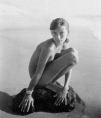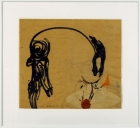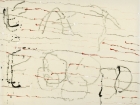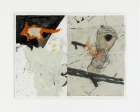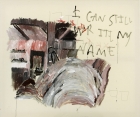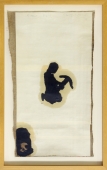
Artist | Jock Sturges (*1947)
https://www.artist-info.com/artist/Jock-Sturges
Biography
Biography
born in 1947
About the work (english / deutsch)
About the work (english / deutsch)
Sexuality is indifferent, eroticism singular. Octavio Paz (Octavio Paz, Essays 1, Frankfurt am Main 1979, S. 146
The girls are close and yet unapproachable. They are young. They have the "enigmatic loveliness of not-yet-women“ as Rose-Maria Gropp once remarked on the paintings of Balthus. (Rose-Maria Gropp, "König der Katzen - Fürst des Intimen: Der Maler Balthus", in Frankfurter Allgemeine Zeitung, 02.03.1996, Nr, 53) Jock Sturges looks at naked bodies and their seductive potential with a gaze that is already thoroughly familiar to us from Vladimir Nabokovs „Lolita“ (1955) and, more recently from Calvin Klein’s „Obsession" ads featuring Kate Moss. We have tasted knowledge. The depths of our most secret longings have been plumbed, scanned like sensors. Those sensors have created images that reproduce our longings and transform them into a scintillating and many-facetted media reality. Of course, we are knowingly taken in by these images. That is why we arm ourselves with an arsenal of „discursive arguments“ in our bid to get at these images - to get under their skin, as it were. In Jock Sturges’ photographs, admiration or rejection are very much in the foreground. The very idea of someone parading our no-Ionger secret longings before our very eyes yet again ... a sense of indignation brands these images like the writing on the wall.
The fact of the matter is that today, we merely relate this to certain signals, but not to their origins and intention in the sense of a constitutive starting point.
How are visual signals received and how are they explored? The photographs by Jock Sturges teeter on the razor’s edge. They often threaten to tip the balance in the wrong direction because, today, the border between personal images and instrumentalised images is blurred. The dichotomy - that beauty (lies and deception) is the preserve of advertising, while truth is the preserve of art excludes the yearning that recognises the truth in beauty. This, I believe, is the key to Jock Sturges’ work. He addresses ideals that arouse a transient yearning. Extending the transient means labouring against death.
The eroticism that informs Jock Sturges’ photographs is, on the one hand, a metaphor of the Potential that awaits fulfilment. On the other hand, the metaphor expresses the hope of being able to take the path towards fulfilment in a different way - the hope that disillusion will not prove to be illusion.
Such is the incredible power of intimacy these images possess. The lyricism of these photographs lies in the ecstatic potential of creating IMAGES in the first place.
These photographs are close and unapproachable because yearning is not fulfilled, but constantly has to be nourished anew. It is not the unfulfilled we perceive, but the awareness of being unfulfilled.
Beauty must be constantly recreated as truth. How brief, in life, is the awareness of beauty as a naive, intact sense of identity? It is as though Jock Sturges allows this brief sense of beauty, transcending the ephemeral, to live on in his photographs - not in the sense that he „stands still“, or in the sense that he obsessively transfers his own physicality to the physicality of the young girls, but in the sense that he sounds out an instance which sustains a sense of wonder. We circumscribe this sense of beauty as utopian or paradisical ... The question is how we cope with such feelings. Do we perpetuate them because we do not want to grow up? Because we yearn for an illusion? Or do we accept them as an aspect of strength that preserves our yearning and wonder? If we do not regard Jock Sturges’ photographs as metaphors, we fall into the trap of prejudice and cliché, denying and destroying ourselves in our memory of self because our talk constantly focuses on the conditions under which these images were created, and because we talk as though the individual were a hopeless product in the „enlightening discourse of self-discovery“.
Jock Sturges preserpes for himself a moment of happiness, a moment of natural uninhibitedness, which we progressively deconstruct and compensate in excessive forms.
The eroticism in Jock Sturges’ photography begins where it transcends sexuality and presents it as a metaphor. Given the extent to which the media and comprehensive knowledge of sexuality have undermined eroticism, it is an undertaking that defies belief. Whatever manifests itself as eroticism is a „sublimated“ image derived from knowledge of trivial sexuality. Yet Jock Sturges’ photographs have nothing to do with sexuality. Only with eroticism, with a sensuality that leads each movement of the body and each expression of the body back to its origins.
In 1961, Octavio Paz wrote:
„What captures eroticism is the individual himself, in the sphere of his image, in the sphere of the self Creation, invention: nothing is more real than this body I imagine, and nothing less real than this body I touch, that turns into a pillar of salt, a pillar of smoke. Eroticism is the experience of life to the full, for it appears to us as a tangible entity into which we also step as an entity. At the same time, it is an empty life that sees itself and proects itself It imitates and invents itself. A total experience that is never quite fulfilled because it is its nature to remain, a beyond for ever. The foreign body is an obstacle or a bridge; it has to be crossed one way or the other. The desire, the erotic imagination, the erotic vision permeates the body, making it transparent. Or it destroys it. Beyond you, beyond me, through the body, in the body, beyond the body, we want to see something. That something is erotic fascination; it is that which leads me out of myself and towards you, and what lets me go beyond you. We do not know exactly what it is, except that it is something more. More than history, more than sexus, more than life, more than death."
German text by Jean-Christophe Ammann / Ishbel Flett
(Extract - Full printed version available in the Museum)
MMK - Museum für Moderne Kunst, Frankfurt am Main
„Die Sexualität ist indifferent, die Erotik singulär“ Octavio Paz (Octavio Paz, Essays 1, Frankfurt am Main 1979, S. 146)
Die Mädchen sind nah und unnahbar. Sie sind jung. Sie besitzen die „enigmatische Leiblichkeit von Noch-nicht-Frauen“ wie dies Rose-Maria Gropp für die Bilder des Malers Balthus festgestellt hat. (Rose-Maria Gropp, "König der Katzen - Fürst des Intimen: Der Maler Balthus", in Frankfurter Allgemeine Zeitung, 02.03.1996, Nr, 53) Der Blick von Jock Sturges auf die nackten Körper und deren verführerisches Potential ist uns längst bekannt seit Vladimir Nabokovs „Lolita“ (1955) bis zu Kate Moss, die für „Obsession“ von Calvin Klein posiert. Wir sind vielwissend geworden. Die geheimsten Regungen, die uns bewegen, sind Sensoren gleich abgetastet worden. Diese Sensoren haben Bilder geschaffen, die diese Regungen reproduzieren und in eine schillernde, vielfältige mediale Wirklichkeit umwandeln. Natürlich gehen wir diesen Bildern wohlwissend auf den Leim. Deshalb operieren wir mit einem Arsenal von „diskursiven Argumenten“, um diesen Bildern buchstäblich auf den Leib zu rücken. Bei den Fotos von Jock Sturges stehen Bewunderung oder Ablehnung im Vordergrund. Die Haltung: Es darf ja nicht wahr sein, daß uns jemand nochmals oder erneut die längst entlarvte Sehnsucht vor Augen führt, brandmarkt die Bilder wie ein Menetekel.
Tatsache ist, daß wir heute Signale identifizieren, nicht aber deren Herkunft und Intention im Sinne einer konstitutiven Ausgangssituation.
Wie empfängt, wie eruiert man Bildsignale? Die Bilder von Jock Sturges sind eine einzige Gratwanderung. Sie sind häufig „auf der Kippe“, weil sich die Grenze zwischen eigenen und instrumentalisierten Bildern verwischt. Die Dichotomie: Schönheit, (Lug und Trug) ist Sache der Werbung, Wahrheit dagegen Sache der Kunst, schließt jene Sehnsucht aus, die die Schönheit nur in der Wahrheit, nicht aber die Wahrheit in der Schönheit anerkennt. Letzteres scheint mir für Jock Sturges unumgänglich. Er spricht Ideale an, die nur transitorisch die Sehnsucht wachhalten. Die Verlängerung des Transitorischen ist Arbeit gegen den Tod.
Die Erotik, die Jock Sturges Bilder kennzeichnet, ist zum einen Metapher für ein Potential, das der Erfüllung hart. Zum anderen drückt die Metapher aus, den Weg dieser Erfüllung nochmals, aber anders beschreiten zu können, die Enttäuschung nicht als Täuschung zu erleben.
Das ist die unerhörte Kraft des Intimen, die die Bilder auszeichnet. Die Poetik der Bilder besteht in der ekstatischen Möglichkeit, überhaupt BILDER zu schaffen.
Nah und unnahbar sind diese Bilder, weil die Sehnsucht nicht erfüllt, sondern stets von neuem genährt werden muß. Nicht das Unerfüllte schwingt mit, sondern die Erkenntnis des Unerfülltseins. Schönheit will als Wahrheit stets von neuem geschaffen werden. Wie kurz im Leben ist das Bewußtsein von Schönheit als ein naives, intaktes Gefühl von Identität? Es ist, als ob Jock Sturges dieses kurze Gefühl der Schönheit, diese Transzendierung des Vergänglichen in seinen Bildern weiterleben läßt, nicht im Sinne, daß er „stehenbleibt“, daß er obsessiv die eigene Körperlichkeit in jene der jungen Mädchen verlagert. Vielmehr tut er dies im Aushorchen einer Instanz, welche das Staunen am Leben erhält. Diese Gefühle umschreiben wir als Utopie, als paradiesisch ... Die Frage ist, wie gehen wir mit solchen Gefühlen um? Perpetuieren wir sie, weil wir nicht erwachsen werden wollen? Weil wir einer Illusion nachhängen? Oder akzeptieren wir sie als ein starkes Moment, das uns Sehnsucht und Staunen bewahrt? Wenn wir die Bilder von Jock Sturges nicht als Metapher verstehen, begeben wir uns in die Niederungen der Vorurteile und Alltagsklischees, wir verleugnen und entleiben uns in der Erinnerung an uns selbst, weil wir stets nur über die Bedingungen reden, weil wir so reden, als wäre der Mensch ein hoffnungsloses Produkt im „aufklärerischen Diskurs der Selbstfindung“.
Jock Sturges bewahrt sich ein Moment des Glücks, der Unbefangenheit, das wir fortschreitend abbauen, um es in exzessiven Formen zu kompensieren. Die Erotik in den Bildern von Jock Sturges setzt dort ein, wo sie Sexualität transzendiert, als Metapher setzt. Das ist ein kaum glaubhaftes Unterfangen, hat doch die Medialisierung und das allumfassende Wissen über die Sexualität die Erotik unterwandert. Was immer sich als Erotik manifestiert, ist ein aus dem Wissen der trivialen Sexualität abgeleitetes „sublimiertes“ Bild. Mit Sexualität haben die Bilder von Jock Sturges dennoch nichts zu tun. Nur mit Erotik, mit einer Sinnlichkeit, die jede Bewegung des Körpers und jeden Ausdruck dieses Körpers auf seine Ursprünge zurückführt.
Octavio Paz schreibt 1961:
„Was die Erotik einfängt, ist der Mensch selbst, im Bereich seines Bildes, im Bereich seiner selbst. Schöpfung, Erfindung: nichts wirklicher als dieser Körper, den ich imaginiere; nichts weniger wirklich als dieser Körper, den ich berühre und der zu einem Haufen Salz wird oder in einer Rauchsäule sich verflüchtigt. Mit diesem Rauch wird mein Verlangen einen anderen Körper finden. Die Erotik ist die Erfahrung des vollen Lebens, da es uns als greifbares Ganzes erscheint, in das wir auch als eine Ganzheit eintreten; zugleich ist sie das leere Leben, das sich selbst sieht, das sich selbst darstellt. Sie ahmt nach und erfindet sich; sie erfindet und ahmt sich nach. Totale Erfahrung, die sich nie ganz verwirklicht, weil es ihr Wesen ist, immer ein Jenseits zu sein. Der fremde Körper ist ein Hindernis oder eine Brücke; in dem einen wie in dem anderen Fall muß man ihn überschreiten. Das Verlangen, die erotische Imagination, die erotische Schau, durchdringt die Körper, macht sie transparent. Oder es vernichtet sie. Jenseits von dir, jenseits von mir, durch den Körper, im Körper, jenseits des Körpers wollen wir etwas sehen. Dieses Etwas ist die erotische Faszination, das, was mich aus mir herauszieht und zu dir führt: was mich über dich hinausgehen läßt. Wir wissen nicht genau, was es ist, nur das es etwas mehr ist. Mehr als die Geschichte, mehr als der Sexus, mehr als das Leben, mehr als der Tod.“
Text von Jean-Christophe Ammann
(Auszug - Der vollständige Text ist als Informationsblatt beim Museum erhältlich)
MMK - Museum für Moderne Kunst, Frankfurt am Main
Published Work
Published Work
The last Day of Summer, with an essay by Jayne Anne Phillips, Aperture Foundation, New York 1991
Radiant Identities, Introduction by Elizabeth Berverly and epilog by A. D. Coleman, Aperture Foundation, New York 1994
Evolution of Grace, Gakken Books, Tokyo 1994
 offers / Requests offers / Requests  |
About this service |
|---|
 Exhibition Announcements Exhibition Announcements  |
About this service |
|---|
 Visualization |
Learn more about this service | ||
|---|---|---|---|

Interested in discovering more of this artist's networks?
3 easy steps: Register, buy a package for a visualization, select the artist.
See examples how visualization looks like for an artist, a curator, or an exhibition place: Gallery, museum, non-profit place, or collector.

Exhibition History

|
SUMMARY based on artist-info records. More details and Visualizing Art Networks on demand. Venue types: Gallery / Museum / Non-Profit / Collector |
||||||||||||
| Exhibitions in artist-info | 30 (S 12/ G 18) |
Did show together with - Top 5 of 344 artists (no. of shows) - all shows - Top 100
|
||||||||||
| Exhibitions by type | 30: 23 / 6 / 1 / 0 | |||||||||||
| Venues by type | 23: 18 / 4 / 1 / 0 | |||||||||||
| Curators | 4 | |||||||||||
| artist-info records | Sep 1991 - Apr 2011 | |||||||||||
|
Countries - Top 5 of 8 United States (11) Germany (9) Canada (3) Switzerland (2) Belgium (1) |
Cities - Top 5 of 19 Berlin (3) Boston (3) Toronto (3) Chicago (3) Frankfurt am Main (3) |
Venues (no. of shows )
Top 5 of 23
|
||||||||||
Curators (no. of shows)
Top 4 of 4
|
| Museum - MMK | G | Sep 2010 - Apr 2011 | Frankfurt am Main | (106) | +0 | |
| Stephen Bulger Gallery | S | Nov 2009 - Jan 2010 | Toronto | (162) | +0 | |
| Christophe Guye Galerie | S | Oct 2007 - Nov 2007 | Zürich | (35) | +0 | |
| Kamera- und Fotomuseum Leipzig | G | Sep 2002 - Jan 2003 | Mölkau | (69) | +0 | |
| Walter Storms Galerie München | G | Feb 2002 - Apr 2002 | München | (94) | +0 | |
| Butters Gallery | G | Feb 2001 - Feb 2001 | Portland | (26) | +0 | |
| Keep reading |














